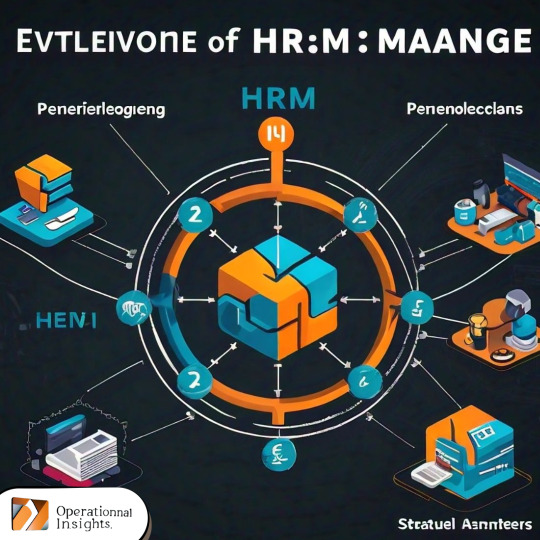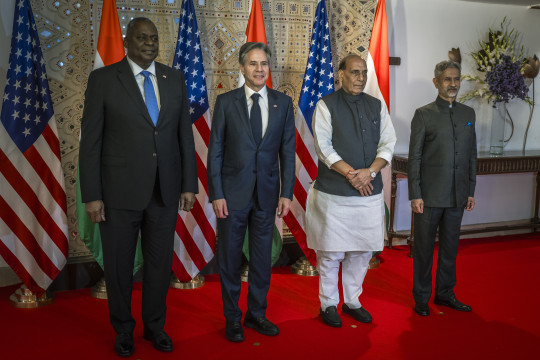#strategicpartner
Explore tagged Tumblr posts
Text
#DearEmployer
Here are just a few of the reasons we believe we are the ideal #learnership training partner for your company👇
🎯 SETA & QCTO accredited
🎯 BBBEE Level 1 status
🎯 100% black female ownership
🎯 135% procurement recognition level
🎯 10 years experience in delivering quality vocational education and training prog rammes;
🎯 Turnkey project management
🎯 Classroom, distance, online and blended mode training
🎯 Highly qualified and experienced facilitators, assessors and moderators
🎯 100% completion rate
🎯 100% training ROI
#skillsdevelopment#skillsjunction#strategicpartner#trainingprovider#vocationaltraining#beepartner#qcto accredited#seta accredited#learnerships
2 notes
·
View notes
Text
The Evolution of HRM: From Personnel Management to Strategic Partner

The evolution of Human Resource Management (HRM) over the past century reflects a profound shift from an administrative function to a central strategic role within organizations. Initially emerging as “personnel management,” the field focused primarily on labor relations, compliance, and record-keeping. However, in response to global economic shifts, technological advancements, and changes in workforce dynamics, HRM has expanded to play a critical role in business strategy, international relations, and social responsibility. This essay traces HRM’s journey from its roots in personnel management to its modern role as a strategic partner, examining the key milestones, contextual influences, and future directions shaping this transformation.
Early Days: Personnel Management
Personnel management’s origin dates to the Industrial Revolution, when labor became essential to large-scale production. Initially, the role was centered on ensuring smooth operations, addressing grievances, and maintaining productivity. However, in the aftermath of World War II, personnel management in the United States and other industrialized nations took on a distinct, more regulated form as governments introduced labor laws to protect workers’ rights. During this period, personnel management focused narrowly on compliance, maintaining records, and handling employee grievances. This limited scope often marginalized HR departments, reducing them to administrative units focused on implementing basic employee-related policies.
In the U.S. during the 1960s, the field experienced a lull, as personnel management was seen as a purely operational function with minimal impact on business strategy. As a result, personnel management courses in universities lacked prestige, often viewed as a fallback for students with limited career options or those with military backgrounds. This perception, coupled with the limited responsibilities and influence of personnel managers, stunted the field’s growth, leaving personnel management as a reactive department focused on following regulations rather than contributing to business strategy.
Revival and Expansion
The 1970s and 1980s witnessed a transformation in HRM, driven by economic, political, and social forces. The U.S. civil rights movement and equal employment legislation profoundly influenced the HR function, creating new opportunities for diversity and inclusion in the workplace. Organizations were increasingly expected to implement fair employment practices, address discrimination, and create inclusive work environments. These societal pressures required personnel management to expand beyond administrative tasks and take a more active role in shaping organizational culture, policies, and training programs.
Simultaneously, economic shifts such as the oil crisis, increasing competition, and technological advancement challenged organizations to improve productivity and innovation. Consequently, HR professionals began to recognize the importance of employee engagement, organizational culture, and leadership development as drivers of business success. New disciplines, such as organizational behavior and industrial psychology, provided HR with tools to understand and manage the complexities of human behavior in the workplace. These insights helped shape modern HR practices, making the transition from personnel management to HRM inevitable as organizations saw value in investing in training, development, and performance management.
This period also saw the development of frameworks such as McGregor’s Theory X and Theory Y, which proposed different management styles and their implications for employee motivation and engagement. Theory X presented a more traditional, authoritative management approach, while Theory Y advocated a participative style. These theories underscored the idea that employees could be self-motivated and that organizations should nurture their potential, a concept that resonated with the evolving vision of HRM. By the 1980s, HRM was seen not only as a way to manage administrative functions but also as a means of aligning employee performance with organizational goals.
Internationalization and Strategic Partnership
With the acceleration of globalization in the late 20th century, HRM had to adapt to the complexities of managing a geographically dispersed and culturally diverse workforce. Multinational corporations needed HR professionals to understand different labor laws, cultural norms, and business practices in regions where they operated. HRM evolved to address these challenges, leading to the rise of International Human Resource Management (IHRM), which focuses on managing people across borders, adapting HR practices to local contexts, and navigating international regulations.
In addition, the rise of global competition and the shift from manufacturing to service economies placed pressure on organizations to innovate and retain top talent. This development elevated HRM from an operational to a strategic function, as organizations realized that effective talent management, leadership development, and succession planning were essential to sustaining competitive advantage. As a result, HR professionals became strategic business partners, contributing to business planning, identifying future workforce needs, and aligning HR practices with organizational goals.
In this new role, HRM emphasized concepts like talent acquisition, competency mapping, and performance-based compensation. The Strategic Human Resource Management (SHRM) model emerged, advocating for HR practices that were directly tied to business objectives. This approach fostered collaboration between HR departments and executive leadership, enabling HR to contribute to critical decisions, including mergers and acquisitions, global expansion, and organizational restructuring. For example, the integration of HR in strategic planning was evident in the success of companies like IBM, which relied on HR to navigate the complexities of global talent acquisition and development as it transitioned from a hardware company to a global technology leader.
Contemporary HRM
Today’s HRM functions are shaped by rapid technological advancements, demographic shifts, and the rising importance of social and environmental responsibility. The modern HR landscape includes a wide range of functions, such as data analytics, talent management, diversity and inclusion initiatives, and organizational development. HR professionals leverage technology and analytics to improve recruitment, assess employee engagement, and predict turnover, helping organizations make data-driven decisions. This trend, known as HR analytics, has enabled HR departments to measure the effectiveness of HR initiatives, justify investments, and identify areas for improvement.
Furthermore, contemporary HRM has expanded to address workforce dynamics and employee expectations, such as remote work, flexible scheduling, and work-life balance. The COVID-19 pandemic accelerated these changes, forcing organizations to re-evaluate traditional work arrangements and adopt digital tools for virtual collaboration. As remote work became more prevalent, HR had to develop policies that fostered inclusivity, engagement, and productivity in a virtual environment.
Social responsibility and sustainability have also become integral to HRM, as employees increasingly prioritize organizations that align with their values. Many HR departments now play a pivotal role in implementing Corporate Social Responsibility (CSR) initiatives, promoting diversity and inclusion, and establishing ethical guidelines. HR professionals are expected to foster an organizational culture that supports social responsibility, environmental stewardship, and transparent governance. For instance, companies like Patagonia and Ben & Jerry’s have demonstrated that aligning business practices with social values can attract and retain employees, enhance brand reputation, and drive customer loyalty.
Future Directions
Looking ahead, HRM is poised to continue its evolution as it navigates emerging trends and challenges. Artificial intelligence (AI) and machine learning are transforming HR functions, enabling organizations to automate repetitive tasks, enhance recruitment processes, and provide personalized learning experiences. For example, AI-powered tools can screen resumes, assess candidates’ cultural fit, and identify high-potential employees, making recruitment more efficient and data-driven. Additionally, AI-driven learning platforms allow employees to develop skills at their own pace, supporting continuous learning and career development.
HRM is also expected to address the implications of an aging workforce, increasing gig economy participation, and the demand for skills-based hiring. As traditional employment models shift, HR professionals will need to balance full-time employees with contingent workers, freelancers, and contractors, creating agile teams that can adapt to changing business needs. This trend requires HR to rethink benefits, employee engagement, and performance management, as the workforce becomes more diverse and decentralized.
Finally, as organizations face mounting pressure to address social issues such as racial equality, mental health, and environmental sustainability, HRM will play a vital role in shaping organizational policies, fostering inclusive cultures, and supporting employee well-being. The future of HRM will likely involve a greater emphasis on ethical leadership, transparency, and resilience, as HR professionals work to create positive social impacts within and beyond their organizations.
Conclusion
The journey of HRM from personnel management to a strategic partner underscores the adaptability and resilience of this field. As HRM has evolved, it has transitioned from an administrative role focused on compliance to a comprehensive function central to organizational success. By addressing the challenges of globalization, technological advancement, and workforce diversity, HRM has established itself as a critical partner in achieving business objectives. Looking to the future, HRM’s focus on people, innovation, and social responsibility will remain essential to navigating the complexities of an increasingly interconnected world. The field’s evolution highlights the importance of human capital as a driving force for organizational growth, innovation, and social impact, ensuring HRM will continue to be a dynamic and influential domain in the decades to come.
#TheEvolutionOfHRM#FromPersonnelManagementToStrategicPartner#HRMHistory#PersonnelManagement#StrategicPartner#HumanResourceManagement#HRAnalytics#Internationalization#Globalization#TalentManagement#OrganizationalDevelopment#Sustainability#SocialResponsibility#WorkforceDiversity#OrganizationalSuccess
0 notes
Text
#DigitalMarketingExcellence#ExpertsChoice#MarketingInnovation#TailoredSolutions#StrategicPartner#OnlineSuccess#IndustryInsights#MarketingMastery#DynamicLearning#ProvenResults#ExpertEndorsement#InnovativeStrategies#DigitalSuccess#DataDrivenMarketing#CuttingEdgeInsights#MarketingGurus#EffectiveCampaigns#OptimizedPerformance#DigitalTransformation#MarketingToolbox#ClientSuccessStories#ContinuousLearning#IndustryLeadership#StrategicDigitalPartnership#ClientFocusedApproach#DigitalMarketingTrends#ROIExcellence#MarketingWizardry#FutureOfMarketing#MarketingEvolution
1 note
·
View note
Text
Over seven projects are added by Maestro Realtek within the first year of operations.
Targeting over Rs. 1000 crore saleable inventory in 2023 – 2024, Maestro Realtek, a knowledge-driven and trusted strategic partner for real estate developers has emerged as one of the leading real estate mandate holders in the Pune realty sector building a strong market presence.
The company has successfully added over seven prestigious projects by renowned developers to its portfolio within the first year of operations. Some of the notable projects include Real Homes by GADA Group, Signature Villas by Adarsh Group, Menlo - X Factor at Koregaon Park, Kharadi 2.0 Residential, Business Hub & Professional Park, Codename Kingsize by Nandgude Patil and Sneha Constructions amongst others.
Maestro Realtek offers real estate developers and landowners comprehensive end-to-end assistance from growth strategies to land acquisition for business expansion, sales, marketing, and CRM. With their expertise in velocity selling, their primary goal is to rapidly and effectively accelerate clients' sales. Moreover, the company leverages cutting-edge technology, data analytics, and market-driven approaches to ensure significant profitability and remarkable cash flow for its clients.
Nitin Gupta, Founder & Managing Director, Maestro Realtek said, “It’s our vision to add long-term value to the real estate industry. We are delighted with the positive market response to our solutions approach. Securing these exciting projects from some of Pune’s well-known real estate developers demonstrates their confidence in our capabilities. Maestro Realtek's commitment to leveraging knowledge and expertise to create a meaningful impact on businesses sets us apart. Our real focus is to build strong brands and ultimately contribute to real estate success stories through a complete 360° business transformation.”
1 note
·
View note
Text
Weave a Safety Net—Find the Right Strategic Partners
The pandemic was a wormhole. It hurtled us into the future with no time to prepare for that demanding new reality. I am still evaluating the lessons learned. One message that rings loud and clear is the importance of connections. Isolation taught us the value of the relationships and the technology that sustained our communities. I’ve told these stories before, but I’m referring to them again…

View On WordPress
#assnchat#assnconsult#association40#orgsherry#sherryconnects#strategicpartners#@brentgibson#@Kristinehillmer#@nancymacrae#@orgcommunity#@orgsource
0 notes
Video
Security & Stability: U.S. Special Operations Command Africa's Joint Com...
#youtube#securityandstability USSOCAfrica JointCombinedExchangeTrainings USMilitary specialoperations training Africa defensesupport strategicpartner
0 notes
Text
Business benefits of a value-driven methodology

We are dedicated to delivering solutions that go beyond just fulfilling requirements. Our value-driven approach ensures that every project we undertake adds measurable value to your business, paving the way for success and growth. Let us be your strategic partner and together, we'll turn your visions into reality! 🚀💡
#theantfirm#businesswebsite#WebsiteDesign#Website#ValueDrivenApproach#BusinessBenefits#StrategicPartner#SuccessAndGrowth#ValueCreation#TransformingVisions#BusinessSolutions#DeliveringValue#UnlockingPotential#InnovationMatters#branding#creativeagency#design#designinspiration#digitalmarketing#webdevelopment#webagency#webdesign
0 notes
Text

Attention all accounting firms! Are you tired of spending countless hours on administrative tasks and struggling to meet deadlines? We've got a solution for you! Our highly skilled team of professionals is here to provide you with top-quality services at a fraction of the cost. So why wait? Take advantage of our offshore staffing solutions today and start experiencing the benefits of a more efficient accounting practice. Contact us to learn more about how we can help your firm thrive!
#cpafirm #accountingfirm #accountingfirms #accountingfirmlife #helpfulaccountants #cpaproblems #cpaproblemsolver #AccountingFirms #offshorestaffing #skilledprofessionals #DeadlineDriven #OutsourcingSolutions #BusinessSolutions #ProductivityBoost #RemoteWorkforce #ClientSatisfaction #BusinessGrowth #VirtualTeam #OutsourcingPartner #StrategicPartner #BusinessSupport #WorkSmarterNotHarder #TeamExpansion #remotestaffing
#thrive!#cpafirm#accountingfirm#accountingfirms#accountingfirmlife#helpfulaccountants#cpaproblems#cpaproblemsolver#AccountingFirms#offshorestaffing#skilledprofessionals#DeadlineDriven#OutsourcingSolutions#BusinessSolutions#ProductivityBoost#RemoteWorkforce#ClientSatisfaction#BusinessGrowth#VirtualTeam#OutsourcingPartner#StrategicPartner#BusinessSupport#WorkSmarterNotHarder#TeamExpansion#remotestaffing#outsourceaccounting#offshore account no minimum#offshore outsourcing services#offshoreaccounting#taxseason
1 note
·
View note
Photo

iCar Asia Limited #hiring for multiple positions. Fresher & Experience Jobs - ReferIndia #hiring #icarasia #limitedcompany #assistantmanager #strategicpartner #bussinessdevelopment #execusive #growthproduct #manager #salesexecutive #seniorsoftware #engineer #PHP #telesalesexecutive #referindia. (at Mumbai, Maharashtra) https://www.instagram.com/p/CVwqYEttOpL/?utm_medium=tumblr
#hiring#icarasia#limitedcompany#assistantmanager#strategicpartner#bussinessdevelopment#execusive#growthproduct#manager#salesexecutive#seniorsoftware#engineer#php#telesalesexecutive#referindia
0 notes
Photo

Proceedings are underway for @tatamotorsgroup to have a foreign strategic partner in place for its passenger vehicle business through a Rs 9417 crore transfer of the unit to a wholly-owned subsidiary. The auto major is said to be in talks with multiple automakers from Europe and East Asia, to sell up to 49 percent stake in its India passenger vehicle business. #TataMotors #globalalliance #strategicpartner #PVbusiness #biztransfer #bizvdnews #businessnews #newsupdate #newsoftheday #businessnewsdaily #businessnewsindia #indianmarket https://www.instagram.com/p/CDdfzSzDGmW/?igshid=7mt96cw9kkba
#tatamotors#globalalliance#strategicpartner#pvbusiness#biztransfer#bizvdnews#businessnews#newsupdate#newsoftheday#businessnewsdaily#businessnewsindia#indianmarket
0 notes
Text
0 notes
Photo

Friends in the Industry - In our March edition of the Truck Focus Newsletter, our industry leader Shiva Bhardwaj, CEO, and Founder of Pitstop Connect shares an incredible article that dives into his top 5 mobility predictions by 2030. Check out the article now! https://bit.ly/3vN4rET I highly recommend learning more about Pitstop Connect https://pitstopconnect.com/ If you have not yet done so, I encourage you to sign up to receive your copy of the Truck Focus Newsletter! https://bit.ly/3F2R9oF As always, let's create a pivotal impact! #PVTL #TruckFocus #TruckFocusPodcast #StrategicPartners #IndustryAdvocate (at Calgary, Alberta) https://www.instagram.com/p/Ca51ozzJfjx/?utm_medium=tumblr
0 notes
Text

My professor once told me...
Always celebrate your milestones!
Royalty General Construction is 35-years old this month!
Proudly serving clients across industries, always exceeding expectations, one project at a time!
We're looking forward to the next 35 years!
Congrats to the whole team, past and present.
#construction#constructionsolutions#renovationproject#renovation#strategicpartner#projectmanagment#retailexperience#pharmaceutical
0 notes
Text



Deepening the U.S.-India Defense Partnership: Secretary of Defense Lloyd J. Austin III and Defense Minister Rajnath Singh Hold Talks in New Delhi
Nov. 10, 2023 | By Joseph Clark , DOD News
#USIndiaDefensePartnership #LloydAustin #RajnathSingh #DefenseMinister #DeepeningTies #USIndiaRelations #JointDefenseTalks #USIndiaCooperation #StrategicPartners #MilitaryAlliance #IndiaVisit #BilateralTies #DefenseDiplomacy #SecurityDialogue #StrengtheningPartnership #RegionalStability #GlobalSecurity #MilitaryCollaboration #PeaceandSecurity #UnitedStatesIndia
0 notes
Link
A look at the preparation of a digital strategy from the point of view of long-term business planning and some tips to make a successful digital strategy in 2021.
0 notes
Photo

@cslgroup Your #strategicpartner in... event set up and wedding planning??? Wait, what? Nearly the whole maintenance and enhancement team came together over the last few days to complete this wedding venue set up - installing Ginkgos and PeeGee Hydrangeas, mulching, painting, pruning... making everything on the property look just right. What a tremendous effort. Way to go everybody @cslgroup #cslgroup #csl_ancaster
0 notes